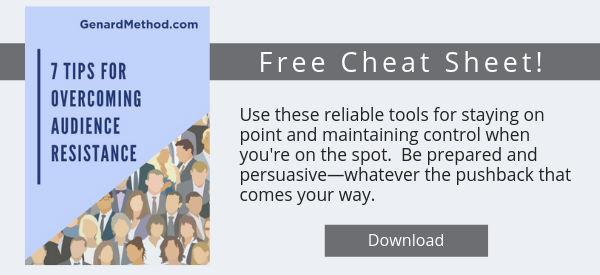What’s your first thought upon hearing that you or your employees have to give a presentation?
Is it: “What will the topic be?”
If it is, you’re in good company. Most of us think along those lines when we know we’re going to be speaking in public. (If you're more comfortable with your content than your listeners, download our cheat sheet, "5 Ways to Captivate an Audience.")
But there’s a much more important question you should ask yourself first: not “What?,” but “Who?” Who's your target audience? For until you know as closely as possible the make-up of your listeners, how do you know what to say to them?
Get Yourself on Your Listeners' Wavelength
In my profession as speech coach, for instance, there are hundreds of speeches I could give on good communication skills. Yet each talk would depend closely upon the age, level of knowledge, sophistication, demographics, and profession of my listeners, along with how they will use the information I give them.
Many other factors may come into play as well, of course. One of the most relevant concerns exactly who that audience really is and why they need to hear what I might say to them. I’m sure it’s the same in your area of expertise. Ask yourself what your listeners really need to hear, for instance (it’s not always what they think they need to hear!). Once you have that information, grab their attention with some foolproof ways to open a speech.
Are there clear preferences concerning how these listeners like to receive information, i.e., do they have a well defined comfort zone? What are their expectations concerning your speech or presentation? Once you know these things, you might ask yourself whether you want to meet those expectations or intentionally confound them.
People Are Easier to Influence than Your PowerPoint Screen
Your first step to achieving your goals with an audience, then, is knowing who you’re dealing with. Yet presenters too often leap onto the information-delivery bandwagon without a moment’s reflection concerning the make-up of their audience.
These speakers are armed and ready to fire off their data points, PowerPoint slides, and quarterly sales figures (often looking at the projection screen the entire time instead of their listeners). They mercilessly subject audiences to bullet-ridden presentations, as though those valuable attendees were the guests of honor at a firing squad. (To succeed instead of driving your audience into a coma, go here to learn "The 4 Golden Rules for Using PowerPoint.")
Even if you're not quite this oblivious to an audience's needs, dumping information on one’s listeners is no way to achieve genuine and lasting influence. Instead, here are a half-dozen questions to ask yourself as you think about what you might like to say to the interested people you’ll be speaking to.[1]
- Who is this audience in terms of maturity, culture, experience, and socio-economic level? (“Culture” here can mean many things besides nationality or geographic origin. Examples include clubs or social groups, departments within a corporation, religious affiliation, and so on.)
- How much information do the listeners already have? What do you need to give them in the way of content that someone else hasn’t?
- What are their expectations and preferences for this presentation? (For example, military gatherings probably expect to see a PowerPoint presentation; leadership teams will almost certainly prefer more time spent on a strategic vision than operational details, etc.)
- Is there an emotional climate regarding this speaking situation that has relevance to your speech? Examples include recent mass layoffs at a company; an announcement of a huge increase in sales for the quarter; the death of a beloved leader, etc. Your audience may be strongly biased toward or against your message, or you personally, based on what they’re feeling at the time you speak. If you’re a new salesperson talking to a longstanding customer, for instance, are you facing a group of managers with whom the previous rep had a particularly warm relationship? In that case, what might you say that would get you off on the right foot?
- Who has spoken to this audience in the past? What did they speak about? What approach did they use, and was it successful? If not, what can you do differently? (In terms of nonverbal communication, for instance, learn the body language secrets you may be broadcasting, or the 5 body language errors that will sink your presentation.)
- What else can your liaison or contact tell you about this audience, the occasion, the personalities involved, or any other relevant information?
By answering these questions, you’ll be much better armed as you approach your engagement. You’ll then be able to put together content that will give these listeners exactly what they need to hear on this particular occasion.[2]
Do that and you’ll have a leg up on succeeding with this and every audience. And also, of course, you'll have greater confidence that you’ll be able to do so.
Key takeaways from this blog:
- If you know you'll be speaking, ask first not "What," but "Who?"
- Your speech depends upon what your audience wants and needs to hear.
- Get off the information bandwagon and rememember your purpose.
- Consider the expectations and preferences of your listeners.
- Be aware of the emotional climate of the speaking situation.
- Find out if others before you have succeeded, and why they did or didn't.
[1] Note that these steps in performing an audience analysis precede putting together the information in your presentation. As stated above: How do you know what you should be telling these people until you know who they are and what they need?
[2] Remember that speaking situations are always particularized, and even speaking to the same audience at different times might benefit from a different approach.



